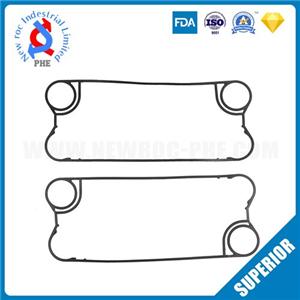Application of Titanium Plate Heat Exchanger in Seawater Desalination
The plate heat exchanger is a highly efficient and compact heat exchange equipment. It was first developed as a continuous low-temperature sterilizer in the 1880s and began to be used in the food industry in the 1920s. Because the plate heat exchanger has some unique features in its manufacture and use, the current plate heat exchanger has been widely used in petroleum, chemical, light industry, electric power, metallurgy, machinery, energy and other industrial fields, becoming a heat exchanger Competitive varieties in the family. Titanium and titanium alloy is a new and promising metal material. The heat exchanger made of titanium has good corrosion resistance, high heat transfer efficiency, smooth surface without scaling layer, small specific gravity, high strength, equipment volume and quality Small and other characteristics, widely used in aviation, space development, ocean engineering, petroleum, chemical industry, metallurgy, electronics, medicine and health, food processing, instrumentation and other fields.
Overview of plate heat exchanger
The plate heat exchanger is a new type of high-efficiency heat exchanger made up of a series of metal sheets with a certain corrugated shape. A thin rectangular channel is formed between various heat exchange plates, and heat exchange is carried out through the heat exchange plates. Compared with conventional shell-and-tube heat exchangers, its heat transfer coefficient is much higher under the same flow resistance and pump power consumption, and it has a tendency to replace shell-and-tube heat exchangers within the applicable range.
Plate heat exchangers, heat exchanger industry plates commonly used materials mainly include cold-rolled sheets such as austenitic stainless steel, titanium and titanium alloys, nickel and nickel alloys. Industrial pure titanium 127 is used in plate heat exchangers, and industrial pure titanium 276 and Ti-0.3Mo-0.8Ni345 are used in tube heat exchangers. The plate heat exchanger made of TA1 titanium plate has many advantages compared with the tubular heat exchanger, and has strong competitiveness in the market. It is mainly used in heat exchange systems such as chemical industry, petroleum, ships, and seawater desalination.
Basic structure of plate heat exchanger
The plate heat exchanger is mainly composed of a frame and two plates. The plate is a thin plate made of various materials that is pressed into corrugations of different shapes with various forms of molds, and four corners of the plate are opened with angular holes for the flow channel of the medium. The periphery of the plate and the corner holes are sealed with rubber gaskets. The frame is composed of a fixed pressing plate, a movable pressing plate, upper and lower guide rods and clamping bolts. The plate heat exchanger is made by superimposing the plates between the fixed compression plate and the movable compression plate, and then clamped by clamping bolts.
Design features of plate heat exchanger
The plate heat exchanger has the following characteristics in design:
1) High efficiency and energy saving: Its heat transfer coefficient is 3000~4500kcal/m2·℃·h, which is 3~5 times higher than the heat efficiency of the shell and tube heat exchanger.
2) Compact structure: The heat exchange plates of the plate heat exchanger are closely arranged. Compared with other heat exchanger types, the plate heat exchanger occupies less floor space and less space. The area is only 1/5 of the shell-and-tube heat exchanger.
3) Easy to clean and easy to disassemble: the plate heat exchanger is clamped by clamping bolts to clamp the clamping plates, so it is convenient to disassemble and can be opened for cleaning at any time. At the same time, because the plate surface is smooth and clean, the turbulence is high, and it is not easy to scale.
4) Long service life: The plate heat exchanger is made of stainless steel or titanium alloy plates, which can be resistant to various corrosive media. The rubber pads can be replaced at will, and it is easy to disassemble and repair.
5) Strong adaptability: The heat exchange plates of the plate heat exchanger are independent components, and the process can be increased or decreased at will according to the requirements, in various forms; it can be applied to the requirements of various different processes.
6) There is no liquid leakage. The heat exchange sealing groove of the plate heat exchanger is equipped with a drain channel, and various media will not collude. Even if there is a leakage, the media will always be discharged.




